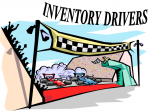 According to the Theory of Constraints a constraint is anything that prevents a process from achieving its goal. Actually there are usually multiple constraints but the one that has the strongest effect is the one concentrated on. To use TOC jargon, that main constraint or bottleneck sets the drum beat (or speed) that the process can run. By using different tools (such as the TOC Thinking Process or Value Stream Maps) each process can be analysed to identify these constraints or bottlenecks. Once the biggest constraint has been identified, the constraint is improved and then the process repeated to identify the next biggest constraint and improve it. As you can tell the cardinal rule in TOC is to concentrate on the main constraint for any process as changes to minor constraints will not affect the overall process (the overall process cannot produce product any faster than the speed of the drumbeat constraint).
According to the Theory of Constraints a constraint is anything that prevents a process from achieving its goal. Actually there are usually multiple constraints but the one that has the strongest effect is the one concentrated on. To use TOC jargon, that main constraint or bottleneck sets the drum beat (or speed) that the process can run. By using different tools (such as the TOC Thinking Process or Value Stream Maps) each process can be analysed to identify these constraints or bottlenecks. Once the biggest constraint has been identified, the constraint is improved and then the process repeated to identify the next biggest constraint and improve it. As you can tell the cardinal rule in TOC is to concentrate on the main constraint for any process as changes to minor constraints will not affect the overall process (the overall process cannot produce product any faster than the speed of the drumbeat constraint).
So how do constraints drive inventory levels? As an example, one of the critical rules of TOC is to never let the bottleneck operation stop. Any time lost at the bottleneck cannot be made up whereas any lost time in a non-bottleneck operation can be. This rule causes organizations to set up a stocking point immediately prior to each bottleneck so that even if there is a supply problem the operation will not be shut down. This, of course, increases overall inventory levels and in far too many cases, even if the bottleneck is improved the stocking point is not removed. In effect, this locks in the higher inventory levels even though they are not needed anymore. But wouldn’t removing these stocking points automatically be part of the improvement process? It should be except that human nature tends to push against it. In the initial improvement, the inclination is to not touch the stocking point until the improvement has been proved effective (just in case). By the time it is proven effective most people have moved on to the next problem and removing the stocking point just gets forgotten. If asked why inventory is so high people tend to reply that the amount is stock is what the computer is calling for and therefore must be the correct amount. In order to remove the inventory you need to change the routings and production plans to remove the stocking point.
So what are some of the other possible constraints that can affect inventory levels? While not meant to be an exhaustive list or in any specific order, here are some other constraints that are commonly found in many organizations:
- Warehouse space
- Shipping / receiving docks
- Logistics
- Total inventory value
- Forecast accuracy
- Lead time
- Government regulations
- Equipment
- Equipment breakdown
- People
- Process flow
- Reporting systems
- Production plan
- Crisis Management (Hurricanes, earthquakes, blizzards…)
- KPIs
As you may have noticed I have talked about many of these as specific Inventory Drivers in previous posts. And what makes each of these factors a constraint? Every one of them restricts the smooth flow of product through your organizational processes, creating problems in your value stream. This is the exact same effect that potholes and bumps would have on the road. Every time your car hits a pothole or a bump in slows down the car and potentially “breaks” the process. You can try driving around them but that slows down the journey and probably isn’t terribly effective any way. So what can we do? Someone needs to smooth out the bumps and fill in the potholes to give a nice smooth surface to drive on. The equivalent smoothing process in most organizations is to add more inventory until the problems are buried and the process can be speeded up. From an inventory management point of view this is NOT an effective response to the problem. Any or all of these, and many others, may affect your organizational flow until your inventory management becomes effectively uncontrollable. The trick is to identify them and the effect they are having on your inventory. Only at that point can you effectively control these drivers and your inventory levels (remove the rocks).
Having issues with your inventory?
Do you understand what Drivers are biasing your inventory levels to move up or down? Do you need help understanding and getting control of your inventory? Contact Ed White at Jade Trillium Consulting to discuss whether we can help your organization and how best to proceed.
Enjoy thinking about Constraints and other Inventory Drivers. Talk to your friends and co-workers about their experience and thoughts on these topics, especially what it means for your organization. And, as always, I would love to hear back on your (and their) thoughts. Just fill in the comment box below along with your contact information to let me know what you think.

